This blog is use only for give you a detail about weapon, sorry about not showing the manufacture and etc.
Blogroll
Douglas A-1 Skyraider (Aircraft)
| A-1 (AD) Skyraider | |
|---|---|
| U.S. Navy A-1H Skyraider from Attack Squadron VA-152 over Vietnam in 1966. | |
| Role | Attack aircraft |
| National origin | United States |
| Manufacturer | Douglas Aircraft Company |
| First flight | 18 March 1945 |
| Introduction | 1946 |
| Retired | 1985 Gabonese Air Force[1] |
| Status | Phased out of service |
| Primary users | United States Navy United States Air Force Royal Navy South Vietnam Air Force |
| Produced | 1945–1957 |
| Number built | 3,180 |
| Developed into | Douglas A2D Skyshark |
The Douglas A-1 Skyraider (formerly AD) was an American single-seat attack aircraft that saw service between the late 1940s and early 1980s. It became a piston-powered, propeller-driven anachronism in the jet age, and was nicknamed "Spad", after a French World War I fighter.[2] The Skyraider had a remarkably long and successful career, even inspiring its straight-winged, slow-flying, jet-powered successor, the A-10 Thunderbolt II[citation needed].
It was operated by the United States Navy (USN), the U.S. Marine Corps (USMC) and the United States Air Force (USAF), and also saw service with the British Royal Navy, the French Air Force, the Air Force of the Republic of Vietnam (VNAF), and others.
Design and development
The piston-engined Skyraider was designed during World War II to meet US Naval requirements for a carrier-based, single-seat, long-range, high performance dive/torpedo bomber, to follow-on from earlier types such as the Helldiver and Avenger. Designed by Ed Heinemann of the Douglas Aircraft Company, prototypes were ordered on 6 July 1944 as the XBT2D-1. The XBT2D-1 made its first flight on 18 March 1945 and in April 1945, the USN began evaluation of the aircraft at the Naval Air Test Center (NATC).[3] In December 1946, after a designation change to AD-1, delivery of the first production aircraft to a fleet squadron was made to VA-19A.[4]The AD-1 was built at Douglas' El Segundo plant in Southern California. In his memoir The Lonely Sky, test pilot Bill Bridgeman quotes a production rate of two aircraft per day, describing the routine yet sometimes hazardous work of certifying AD-1s fresh off the assembly line for delivery to the U.S. Navy in 1949 and 1950.[5]
The low-wing monoplane design started with a Wright R-3350 radial engine, later upgraded several times. Its distinctive feature was large straight wings with seven hard points apiece. These gave the aircraft excellent low-speed maneuverability, and enabled it to carry a large amount of ordnance (more than its own weight in weapons[citation needed]) over a considerable combat radius and loiter time for its size, comparable to much heavier subsonic or supersonic jets. The aircraft was optimized for the ground-attack mission and was armored against ground fire in key locations unlike faster fighters adapted to carry bombs, such as the Vought F4U Corsair or North American P-51 Mustang, which would be retired by U.S. forces before the 1960s.
Navy AD series were initially painted in ANA 623 Glossy Sea Blue, but during the 1950s following the Korean War, the color scheme was changed to light gull grey (FS26440) and white (FS27875). Initially using the gray and white Navy pattern, by 1967 the USAF began to paint its Skyraiders in a camouflaged pattern using two shades of green, and one of tan.
Used by the USN over Korea and Vietnam, the A-1 was a primary close air support aircraft for the USAF and VNAF during the Vietnam War. The A-1 was famous for being able to take hits and keep flying. There was added armor plating around the cockpit area for added pilot protection. It was replaced beginning the mid-1960s by the Grumman A-6 Intruder as the Navy's primary medium attack plane in supercarrier-based air wings; however Skyraiders continued to operate from the smaller Essex class carriers.
The Skyraider went through seven versions, starting with the AD-1, then AD-2 and AD-3 with various minor improvements, then the AD-4 with a more powerful R-3350-26WA engine. The AD-5 was significantly widened, allowing two crew to sit side-by-side (this was not the first multiple-crew variant, the AD-1Q being a two-seater and the AD-3N a three-seater); it also came in a four-seat night-attack version, the AD-5N. The AD-6 was an improved AD-4B with improved low-level bombing equipment, and the final production version AD-7 was upgraded to a R-3350-26WB engine.
In addition to serving during Korea and Vietnam as an attack aircraft, the Skyraider was modified into a carrier-based airborne early warning aircraft, replacing the Grumman TBM-3W Avenger. It served in this function in the USN and Royal Navy, being replaced by the Grumman E-1 Tracer and Fairey Gannet respectively in those services.[6]
Skyraider production ended in 1957 with a total of 3,180 built. In 1962, the existing Skyraiders were redesignated A-1D through A-1J and later used by both the USAF and the Navy in the Vietnam War.
[edit] Operational history
[edit] Korean War
Though the Skyraider was produced too late to take part in World War II, it became the backbone of United States Navy aircraft carrier and United States Marine Corps (USMC) strike aircraft sorties in the Korean War, with the first ADs going into action from the USS Valley Forge with VA-55 on 3 July 1950.[7] Its weapons load and 10-hour flying time far surpassed the jets that were available at the time.[6] On 2 May 1951, Skyraiders made the only aerial torpedo attack of the war—successfully hitting the Communist-controlled Hwacheon Dam.[8] On 16 June 1953, a USMC AD-4 from VMC-1 piloted by Major George H. Linnemeier and CWO Vernon S. Kramer shot down a Soviet-built Polikarpov Po-2 biplane, the only documented Skyraider air victory of the war.[9] AD-3N and -4N aircraft carrying bombs and flares flew night-attack sorties, and radar-equipped ADs carried out radar-jamming missions from carriers and land bases.[6] During the Korean War (1950–1953) A-1 Skyraiders were flown only by the U.S. Navy and U.S. Marine Corps, and were normally painted in dark navy blue. It was called the "Blue Plane" by enemy troops.[10] A total of 101 Navy and Marine AD Skyraiders were lost in combat during the Korean War, and 27 were lost to operational causes, for a total loss of 128 Skyraiders in the Korean War.[edit] Communist China
On 26 July 1954, two Douglas Skyraiders from the aircraft carriers USS Philippine Sea and Hornet shot down two PLAAF La-7s off the coast of Hainan Island while searching for survivors after the shooting down of a Cathay Pacific Skymaster airliner three days previously, also by La-7s.[11][edit] Vietnam
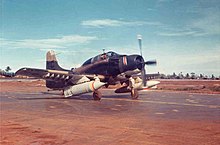
A 1st SOS A-1E carrying a BLU-72/B, 1968.
As they were released from Navy service, Skyraiders were introduced into the South Vietnamese Air Force (VNAF). They were also used by the USAF to perform one of the Skyraider's most famous roles: the "Sandy" helicopter escort on combat rescues.[16] USAF Major Bernard F. Fisher piloted an A-1E on the 10 March 1966 mission for which he was awarded the Medal of Honor for rescuing Major "Jump" Myers at A Shau Special Forces Camp.[17] USAF Colonel William A. Jones, III piloted an A-1H on the 1 September 1968 mission for which he was awarded the Medal of Honor. In that mission, despite damage to his aircraft and suffering serious burns, he returned to his base and reported the position of a downed US airman.[17]
In contrast to the Korean War, fought a decade earlier, the US Air Force, in Vietnam, utilized the naval A-1 Skyraider for the first time. As the Vietnam War progressed, USAF A-1s were painted in camouflage, while USN A-1 Skyraiders were gray/white in color; again, in contrast to the Korean War, when A-1s were painted dark blue.
In 1965, to highlight the dropping of the six millionth pound of ordnance; Commander Clarence J. Stoddard, flying an A-1H, dropped a special, one-time only, object in addition to his other munitions – a toilet.[19]
[edit] South Vietnamese Air Force
The A-1 Skyraider was the close air support workhorse of the South Vietnamese Air Force (VNAF) for much of the Vietnam War. The US Navy began to transfer some of its Skyraiders to the VNAF in September 1960, replacing the VNAF’s older Grumman F8F Bearcats. By 1962 the VNAF had 22 of the aircraft in its inventory,[20] and by 1968, an additional 131 aircraft had been received. Initially Navy aviators and crews were responsible for training their South Vietnamese counterparts on the aircraft, but over time, responsibility was gradually transferred to the USAF.The initial trainees were selected from among VNAF Bearcat pilots who had accumulated 800 to 1200 hours flying time. They were trained at Corpus Christi, Texas., and then sent to LeMoore, California for further training. Navy pilots and crews in Vietnam checked out the Skyraiders that were being transferred to the VNAF, and conducted courses for VNAF ground crews.[21]
Over the course of the war, the VNAF acquired a total of 308 Skyraiders, and was operating six A-1 squadrons by the end of 1965. These were reduced during the period of Vietnamization from 1968 to 1972, as the U.S. began to supply the South Vietnamese with more modern close air support aircraft, such as the Cessna A-37 and Northrop F-5, and at the beginning of 1968, only three of its squadrons were flying A-1s.[22]
As the U.S. ended its direct involvement in the war, it transferred the remainder of its Skyraiders to the South Vietnamese, and by 1973, all remaining Skyraiders in U.S. inventories had been turned over to the VNAF.[23] Unlike their American counterparts, whose combat tours were generally limited to 12 months, individual South Vietnamese Skyraider pilots ran up many thousands of combat hours in the A-1, and many senior VNAF pilots were extremely skilled in the operation of the aircraft.[24]
[edit] Fleet Air Arm use
The Royal Navy acquired 50 AD-4W early warning planes in 1951 though the Military Assistance Program. All Skyraider AEW.1s were operated by 849 Naval Air Squadron, which provided four-plane detachments for the British carriers. One flight took part in the Suez Crisis in 1956 aboard the carrier HMS Bulwark. 778 Naval Air Squadron was responsible for the training of the Skyraider crews at RNAS Culdrose. In 1960, the Fairey Gannet AEW.3 replaced the Skyraiders, using the APS-20 radar of the Douglas aircraft. The last British Skyraiders were retired in 1962.[25] In the late 1960s, the APS-20 radars from the Skyraiders were installed in Avro Shackleton AEW.2s of the Royal Air Force which were finally retired in 1991.[edit] Swedish use
Fourteen British AEW.1 Skyraiders were sold to Sweden to be used by Svensk Flygtjänst AB between 1962 and 1974. All military equipment was removed and the aircraft were used as target tugs with the Swedish armed forces.[25][edit] French use
The French Air Force bought 20 ex-USN AD-4s as well as 88 ex-USN AD-4Ns and five ex-USN AD-4NAs with the former three-seaters modified as single-seat aircraft with removal of the radar equipment and the two operator stations from the rear fuselage. The AD-4N/NAs were initially acquired in 1956 to replace aging Republic P-47 Thunderbolts in Algeria.[26] The Skyraiders were first ordered in 1956 and the first was handed over to the French Air Force on 6 February 1958 after being overhauled and fitted with some French equipment by Sud-Aviation. The aircraft were used until the end of the Algerian war. The aircraft were used by the 20e Escadre de Chasse (EC 1/20 "Aures Nementcha," EC 2/20 "Ouarsenis" and EC 3/20 "Oranie") and EC 21 in the close air support role armed with rockets, bombs and napalm.The Skyraiders had only a short career in Algeria. But they nonetheless proved to be the most successful of all the ad hoc COIN aircraft deployed by the French. The Skyraider remained in limited French service until the 1970s.[26] They were heavily involved in the civil war in Chad, at first with the Armée de l'Air, and later with a nominally independent local air force staffed by French mercenaries. The aircraft also operated under the French flag in Djibouti and on the island of Madagascar. When France at last relinquished the Skyraiders it passed the survivors on to client states, including Gabon, Chad, Cambodia and the Central African Republic.[27](several aircraft from Gabon and Chad have been recovered recently by French warbird enthusiasts and entered on the French civil register).
The French frequently used the aft station to carry maintenance personnel, spare parts and supplies to forward bases. In Chad they even used the aft station for a "bombardier" and his "special stores" – empty beer bottles – as these were considered as non-lethal weapons, thus not breaking the government-imposed rules of engagement, during operations against Libyan-supported rebels in the late 1960s and early 1970s.
[edit] Variants

A VAW-11 AD-5W aboard USS Kearsarge, 1958.
- XBT2D-1
- Single-seat dive-bomber, torpedo-bomber prototype for the U.S. Navy.
- XBT2D-1N
- Three-seat night attack prototypes; only three aircraft built.
- XBT2D-1P
- Photographic reconnaissance prototype; only one built.
- XBT2D-1Q
- Two-seat electronics countermeasures prototype; one aircraft only.
- BT2D-2 (XAD-2)
- Upgraded attack aircraft; one prototype only.
- AD-1
- The first production model; 242 built.
- AD-1Q
- Two-seat electronic countermeasures version of the AD-1; 35 built.
- AD-1U
- AD-1 with radar countermeasures and tow target equipment, no armament and no water injection equipment.
- XAD-1W
- Three-seat airborne early warning prototype. AD-3W prototype; one aircraft only.
- AD-2
- Improved model, powered by 2,700 hp (2,000 kW) Wright R-3350-26W engine; 156 built.
- AD-2D
- Unofficial designation for AD-2s used as remote-control aircraft, to collect and gather radioactive material in the air after nuclear tests.
- AD-2Q
- Two-seat electronics countermeasures version of the AD-2; 21 built.
- AD-2QU
- AD-2 with radar countermeasures and target towing equipment, no armament and no water injection equipment; one aircraft only.
- XAD-2
- Similar to XBT2D-1 except engine, increased fuel capacity.
- AD-3
- Proposed turboprop version, initial designation of A2D Skyshark.
- AD-3
- Stronger fuselage, improved landing gear, new canopy design; 125 built.
- AD-3S
- Anti-submarine warfare model; only two prototypes were built.
- AD-3N
- Three-seat night attack version; 15 built.
- AD-3Q
- Electronics countermeasures version, countermeasures equipment relocated for better crew comfort; 23 built.
- AD-3QU
- Target towing aircraft, but most were delivered as the AD-3Q.
- AD-3W
- Airborne early warning version; 31 built.
- XAD-3E
- AD-3W modified for ASW with Aeroproducts propellor
- AD-4
- Strengthened landing gear, improved radar, G-2 compass, anti-G suit provisions, four 20 mm (.79 in) cannon and 14 Aero rocket launchers, capable of carrying up to 50 lb (23 kg) of bombs; 372 built.
- AD-4B
- Specialized version designed to carry nuclear weapons, also armed with four 20 mm cannon; 165 built plus 28 conversions.
- AD-4L
- Equipped for winter operations in Korea; 63 conversions.
- AD-4N
- Three-seat night attack version; 307 built.
- AD-4NA
- Designation of 100 AD-4Ns without their night-attack equipment, but fitted with four 20 mm (0.79 in) cannon, for service in Korea as ground-attack aircraft.
- AD-4NL
- version of the AD-4N; 36 conversions.
- AD-4Q
- Two-seat electronic countermeasures version of the AD-4; 39 built.
- AD-4W
- Three-seat airborne early warning version; 168 built. A total of 50 AD-4Ws were transferred to the Royal Navy as Skyraider AEW Mk 1.
- AD-5 (A-1E)
- Side-by-side seating for pilot and co-pilot, without dive brakes; 212 built.
- AD-5N (A-1G)
- Four-seat night attack version, with radar countermeasures; 239 built.
- AD-5Q (EA-1F)
- Four-seat electronics countermeasures version; 54 conversions.
- AD-5S
- One prototype to test Magnetic anomaly detector (MAD) anti-submarine equipment.
- AD-5W (EA-1E)
- Three-seat airborne early warning version; 218 were built.
- UA-1E
- Utility version of the AD-5.
- AD-6 (A-1H)
- Single-seat attack aircraft with three dive brakes, centerline station stressed for 3,500 lb (1,600 kg) of ordnance, 30 in (760 mm) in diameter, combination 14/30 in (360/760 mm) bomb ejector and low/high altitude bomb director; 713 built.
- AD-7 (A-1J)
- The final production model, powered by a R3350-26WB engine, with structural improvements to increase wing fatigue life; 72 built.
[edit] Operators
Main article: List of A-1 Skyraider operators
 Cambodia
Cambodia Central African Republic
Central African Republic Chad
Chad France
France Gabon
Gabon South Vietnam
South Vietnam Thailand
Thailand Sweden
Sweden United Kingdom
United Kingdom United States
United States Vietnam
Vietnam
[edit] Survivors
Main article: List of surviving Douglas A-1 Skyraiders
[edit] Specifications (A-1H Skyraider)
Data from McDonnell Douglas Aircraft since 1920[28]
General characteristics- Crew: One
- Length: 38 ft 10 in (11.84 m)
- Wingspan: 50 ft 0¼ in (15.25 m)
- Height: 15 ft 8¼ in (4.78 m)
- Wing area: 400.3 ft² (37.19 m²)
- Empty weight: 11,968 lb (5,429 kg)
- Loaded weight: 18,106 lb (8,213 kg)
- Max. takeoff weight: 25,000 lb (11,340 kg)
- Powerplant: 1 × Wright R-3350-26WA radial engine, 2,700 hp (2,000 kW)
- Maximum speed: 322 mph (280 kn, 518 km/h) at 18,000 ft (5,500 m)
- Cruise speed: 198 mph (172 kn, 319 km/h)
- Range: 1,316 mi (1,144 nmi, 2,115 km)
- Service ceiling: 28,500 ft (8,685 m)
- Rate of climb: 2,850 ft/min (14.5 m/s)
- Wing loading: 45 lb/ft² (220 kg/m²)
- Power/mass: 0.15 hp/lb (250 W/kg)
- Guns: 4 × 20 mm (0.79 in) M2 cannon
- Other: Up to 8,000 lb (3,600 kg) of ordnance on 15 external hardpoints including bombs, torpedoes, mine dispensers, unguided rockets, or gun pods
[edit] Notable appearances in media
The A-1 Skyraider received various nicknames including: "Spad" and "Super Spad" (derived from the aircraft's AD designation, its relative longevity in service and an allusion to the "Spad" aircraft of World War I), "Able Dog" (phonetic AD), "the Destroyer", "Hobo" (radio call sign of the USAF 1st Air Commando/1st Special Operations Squadron), "Firefly" (a call sign of the 602nd ACS/SOS), "Zorro" (the call sign of the 22nd SOS), "The Big Gun," "Old Faithful," "Old Miscellaneous," "Fat Face" (AD-5/A-1E version, side-by-side seating), "Guppy" (AD-5W version), "Q-Bird" (AD-1Q/AD-5Q versions), "Flying Dumptruck" (A-1E), "Sandy" (the 602nd ACS/SOS call sign for Combat Search And Rescue helicopter escort), and "Crazy Water Buffalo" (South Vietnamese nickname).While the Skyraider is not as iconic as some other aircraft, it has been featured in some Vietnam-era films such as The Green Berets (1968), Flight of the Intruder (1991) flying as Sandy escort, and in We Were Soldiers (2002) in the ground support role. The Skyraider also played a computer-generated role in Werner Herzog's Rescue Dawn (2007).[15] Skyraiders were also featured in the classic Korean war movie The Bridges at Toko-Ri (1953). A formation of U.S. Navy A-1s stood in for U.S. Army Air Force P-47s in the 1962 film The Longest Day.
Related Posts
Langganan:
Posting Komentar (Atom)
Popular Posts
-
M270 Multiple Launch Rocket System (MLRS) M270 MLRS Type Multiple rocket launcher Place of origin United States Service hi...
-
AJ (A-2) Savage Role Bomber National origin United States Manufacturer North American Aviation First flight 3 July 19...
-
A-1 (AD) Skyraider U.S. Navy A-1H Skyraider from Attack Squadron VA-152 over Vietnam in 1966. Role Attack aircraft Nationa...
-
Remington 870 Remington 870 Marine Magnum Type Shotgun Place of origin United States Service history Used by See Users...
-
USS Nimitz (CVN-68) at sea near San Diego, CA Career (United States) Name: USS Nimitz Namesake: Fleet Admiral Chester W. Nim...
-
S-2 Tracker An S-2E from VS-41 ready for launching from the USS Bennington (CV-20) Role ASW aircraft Manufacturer Grumman ...
-
S-3 Viking An S-3B Viking launches from a catapult aboard USS Abraham Lincoln . Role Anti-submarine aircraft Manufacturer ...
-
FV 4034 Challenger 2 Challenger 2 on manoeuvres on Salisbury Plain Type Main battle tank Place of origin United Kingdom Se...
-
F-117 Nighthawk Role Stealth attack aircraft [1] National origin United States Manufacturer Lockheed Corporation Lockheed...
-
YF-23 YF-23, nicknamed Gray Ghost (foreground), flying with YF-23 Black Widow II Role Experimental fighter prototype Nationa...

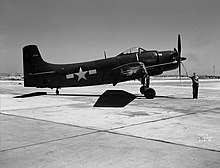




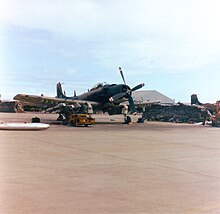


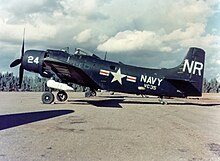


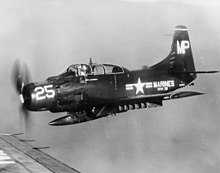



0 komentar:
Posting Komentar